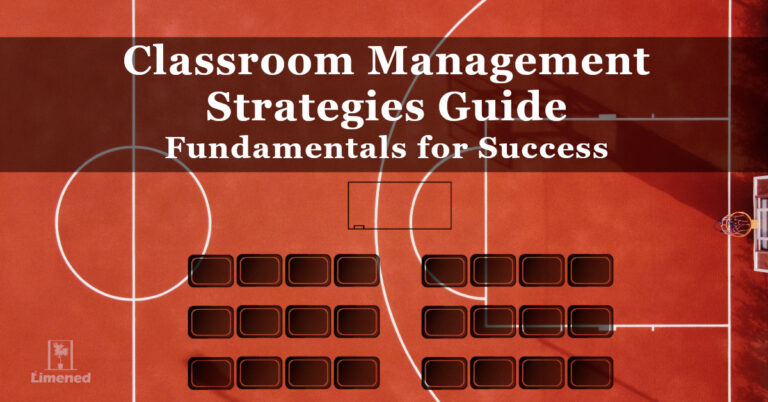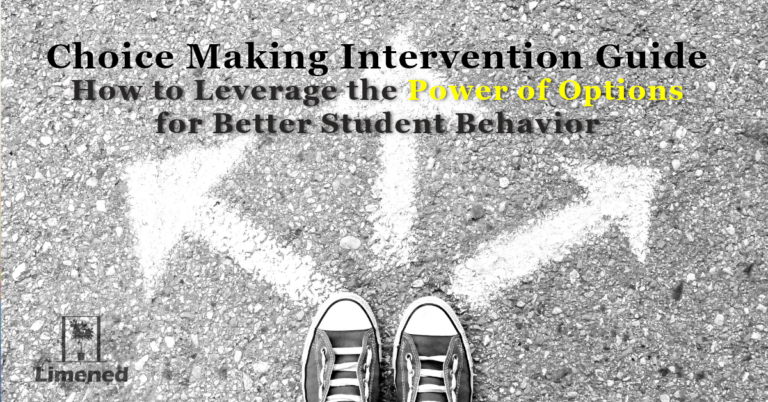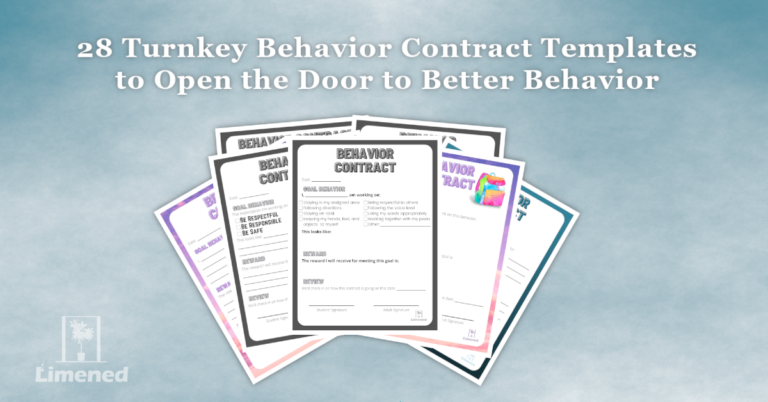We all got into this field to teach. What many of us found, though, is that instead of getting to climb to the summit of Mt. Knowledge with our students, we’re dealing with frequent behavior problems that disrupt…well, everything.
Student behavior is no minor issue in education. Unfortunately, it’s not uncommon for student behavior problems to be cited as a major source of stress and burnout.
So what do we do when student behavior gets in the way of learning? Or when problem behavior steals our joy and passion for this work?
Fortunately, there are a variety of evidence-based strategies that not only reduce problem behavior but also actually promote the kind of learning behavior we desperately want to see more of in our classrooms. And better yet, certain strategies are rather practical and simple in nature, so they’re attainable skills to hold onto in the busy teacher’s toolbox.
In this article, I’ll highlight six such strategies for better student behavior that are supported by valid research, practical, and positive in nature.
Why Address Student Behavior Problems?
I imagine the answer to this question might be rather obvious! And quite personal, in some cases.
That said, I’ve been in some classrooms where student behavior problems are largely ignored without any kind of purposeful approach on the teacher’s behalf, leading to inadvertent disaster. (On the other hand, planned ignoring can be a powerful strategy when implemented intentionally).
Here are five reasons to promote better student behavior in our classrooms:
- Learning Environment: Student behavior directly impacts the learning environment. Disruptive or challenging behavior can create distractions and make it difficult for both the teacher and other students to focus on instruction. By addressing behavior problems, a positive and conducive learning environment can be established, promoting engagement and academic success. And more time actively engaged in instruction simply means more student learning.
- Student Well-being: Behavior problems may indicate underlying emotional, social, or psychological issues that students are facing. Ignoring or neglecting these problems can have long-lasting negative effects on students’ overall well-being, leading them down an undesirable pathway. By addressing behavior problems, we can identify and provide the necessary support and resources to help students navigate challenges and develop essential skills for social and emotional growth. Moreover, all the rest of the students benefit when they don’t experience the stress and disruption that can come with a peer with challenging behavior.
- Teacher Well-being. It’s not just the students who matter, teachers do. You do. You matter as person, not just because of what you can do for the kids. And student behavior problems are one of the most significant sources of stress, burnout, and attrition in our field. Using effective methods to improve student behavior stands to improve your well-being by lowering stress and improving satisfaction with this noble career you’ve chosen.
- Academic Performance: It’s no shocker that student behavior problems can significantly impact academic performance for everyone in the class. Disruptive behavior can disrupt classroom routines and lead to missed instructional time. By addressing behavior problems, teachers can create a structured and supportive environment that fosters academic achievement and allows all students to reach their full potential.
- Social Skills Development: Addressing behavior problems provides an opportunity to teach and reinforce positive social skills, which all students need to learn in order to have their best chance in life. By addressing inappropriate behaviors and teaching prosocial skills, students can develop essential skills such as self-control, problem-solving, empathy, and conflict resolution. These skills are vital for success in school and later in life.
When it comes down to it, addressing student behavior problems is essential for fostering a positive, productive learning environment for all (teachers included!). It’s clearly worth doing! By addressing these challenges proactively, we can help all students thrive academically, emotionally, and socially.
Practical Strategies for Better Student Behavior
There are a variety of effective strategies for student behavior support, some more intensive than others. I’ve specifically highlighted six here that are:
- Practical – they aren’t so complex or resource-intensive that you’d have to be some kind of full-time behavior specialist to implement them.
- Evidence-based – they’ve been evaluated in sound, high-quality studies demonstrating a positive impact on students with challenging behavior.
- Positive & Proactive – these aren’t about waiting for students to fail so we can enact
justicepunishment, focusing instead on setting students up for success in the first place.
1. Ensure a strong foundation of classroom management is in place.
Although we may often start with looking for interventions for student problem behavior, it’s often in our best interests to start with the foundations instead: specifically, classroom management.
Effective classroom management strategies help prevent behavior problems from occurring in the first place. When students understand what is expected of them and have consistent guidelines to follow, they are more likely to exhibit appropriate behavior. This proactive approach reduces the need for reactive behavior interventions later on. And if we do end up needing those interventions, they’ll be much more likely to work in a consistent, predictable, well-managed classroom.
The most effective, core classroom practices include the following:
- Maximize structure and predictability
- Post, teach, review, monitor, and reinforce expectations
- Actively engage students in instruction
- Implement a continuum of responses to acknowledge appropriate behavior
- Implement a continuum of responses to inappropriate behavior
I’ve written a detailed guide on these five classroom management strategies, including video models and resources, right here at Limened:
2. Give more effective directions through precision requests.
It’s not uncommon to have students not respond well to our directions. Some simply don’t do what we ask. Others do but take a looong time getting to it. And others respond with…worse.
It turns out we can actually improve the odds students will follow directions appropriately by how we deliver instructions. Specifically, we can use a strategy called precision requests, which leads to a greater likelihood of compliance. Precision requests include incorporating a set of characteristics of effective commands and following a specific protocol.
Characteristics of effective teacher directions include:
- Coming close to the student
- Making (non-intense!) eye contact
- Using a calm tone of voice
- Giving one specific, positively stated direction at a time
- Allowing wait time for the student to comply
- Reinforcing student compliance
- Remaining neutral and consistent
I walk through these characteristics, the protocol, and other resources here:
3. Provide choices intentionally throughout the day.
Sometimes school is an odd place where students may feel like they have little freedom throughout most or all of the day. And oh do they have things they’d rather do! (Unfortunately, those things don’t always align with our own plans).
We can get ahead of this problem, improving student compliance, engagement, and achievement, simply by being more intentional about providing choices.
Using choice is as simple as it sounds, intentionally and proactively giving students options about non-essentials during different activities throughout the day (especially activities where there are usually student behavior problems).
Pen or pencil?
Paper or computer?
With a partner or on your own?
Work for free choice time or scholar dollars?
Choices as simple as those can have a profound impact on student behavior, and there’s a whole bunch of evidence supporting this simple approach. Not only do students behavior better when given choices, they can actually learn more!
Limened’s Choice Making Intervention Guide provides a deep dive on choice along with videos, tips, and other resources:
And for extra guidance beyond the intervention guide, I’ve written an article that goes deep into planning how to provide choices to students to improve their behavior, including detailed examples and a free planning template:
4. Focus most on what you want with behavior-specific praise.
It’s easy to focus on challenging student behavior, because it often demands our attention. Whereas appropriate student behavior, especially from our more challenging students, often flies under our radar.
However, when it comes to student behavior, we get most of what we pay the most attention to.
That’s why one of the most powerful strategies in our behavior toolbox is simply acknowledging what students are doing right through behavior-specific praise.
Behavior-specific praise is about as simple as it gets, involving providing specific positive feedback to students when they engage in appropriate or expected behavior. Over half a century of research demonstrates the power of praise to improve student behavior, especially when it’s specific, contingent, immediate, individualized, and frequent.
Along with a wealth of relevant resources, you can read all about how to implement behavior-specific praise in my intervention guide:
5. Collaborate with students with a behavior contract.
Sometimes a well-managed classroom with lots of freedom through choices and high rates of positive feedback is just not enough to improve behavior for certain students. They may need a more individualized approach.
It can be helpful, in that case, to work together with the student to lay out exactly what you expect from them as well as identify something motivating as a contingent reward for improvement. A behavior contract is a great way to go about doing just that.
With a behavior contract, you’ll lay out clear expectations for student behavior, any possible supports you might offer, an agreed-upon reward for meeting expectations, and a timeline for the process. You work on this with a student and both sign it, like a real contract (no lawyers needed!). It can be helpful, though not necessary, to use a behavior contract template to guide the process.
Limened’s Behavior Contracts Intervention Guide provides greater detail on how to implement contracts as well as videos, tips, and other resources:
6. Implement high-probability request sequences to get students on a roll.
Sometimes just getting students started on anything is a herculean task. Non-compliance and/or off-task behavior are the name of the game.
The good news is we can create a sort of behavioral momentum that gets students on a roll of following directions by implementing a strategy called high-probability request sequences.
Although the strategy has quite the name, it’s really as simple as asking a student to do a few things they will usually do before you ask them to do that thing they usually won’t. As they follow each direction successfully, you provide some behavior-specific praise or another reinforcer. In essence, you’re getting them on a roll of just being agreeable and doing what you ask.
Whenever I think about this strategy, I think about how unusual it sounds. I mean, ask a student to give you a fist bump, then to pass out papers, before telling them to start the writing prompt they hate…that’s supposed to actually work?? Well…yeah. It is. It does, a lot of the time.
I walk through the ins and outs of this strategy in the High-Probability Request Sequences Intervention Guide, which includes step-by-step guidance, videos, tips, and other resources:
Conclusion
With effective yet practical strategies at hand, teachers can overcome the challenges that come with student behavior problems. The best strategies are proactive and positive, focusing on setting students up for success in the first place. And the treat therein is that once we successfully promote appropriate student behavior, we get to do more of that thing we all got in this to do—teach!











